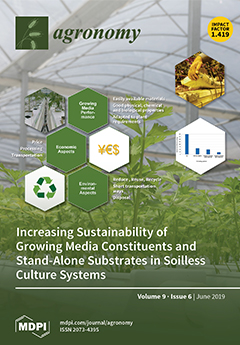Lower quality and longer production periods of grafted seedlings, especially grafted plug seedlings of fruit vegetables, may result from insufficient amounts of light, particularly in rainy seasons and winter. Supplemental artificial lighting may be a feasible solution to such problems. This study was conducted to evaluate light intensity’s influence on the quality of grafted tomato seedlings, ‘Super Sunload’ and ‘Super Dotaerang’ were grafted onto the ‘B-Blocking’ rootstock. To improve their quality, grafted seedlings were moved to a glasshouse and grown for 10 days. The glasshouse had a combination of natural lighting from the sun and supplemental lighting from LEDs (W
1R
2B
2) for 16 h/day. Light intensity of natural lighting was 490 μmol·m
−2·s
−1 photosynthetic photon flux density (PPFD) and that of supplemental lighting was 50, 100, or 150 μmol·m
−2·s
−1 PPFD. The culture environment had 30/25 °C day/night temperatures, 70% ± 5% relative humidity (RH), and a natural photoperiod of 14 h as well. Compared with quality of seedlings in supplemental lighting of 50 μmol·m
−2·s
−1 PPFD, that of seedlings in supplement lighting of 100 or 150 μmol·m
−2·s
−1 PPFD improved significantly. With increasing light intensity, diameter, fresh weight, and dry weight, which were used to measure shoot growth, greatly improved. Leaf area, leaf thickness, and root biomass were also greater. However, for quality of seedlings, no significant differences were discovered between supplement lighting of 100 μmol·m
−2·s
−1 PPFD and supplement lighting of 150 μmol·m
−2·s
−1 PPFD. Expressions of
PsaA and
PsbA (two photosynthetic genes) as well as the corresponding proteins increased significantly in supplement lightning of 100 and 150 μmol·m
−2·s
−1 PPFD, especially in 100 μmol·m
−2·s
−1 PPFD. Overall, considering quality and expressions of two photosynthetic genes and proteins, supplemental light of 100 μmol·m
−2·s
−1 PPFD (W
1R
2B
1) would be the best choice to cultivate grafted tomato seedlings.
Full article





